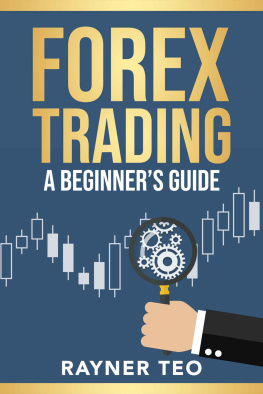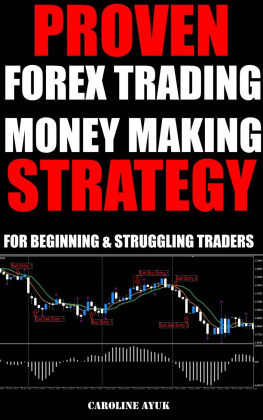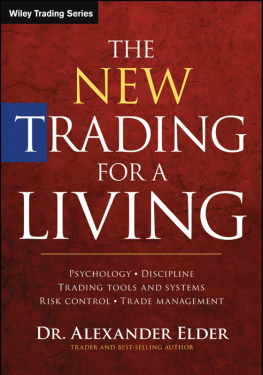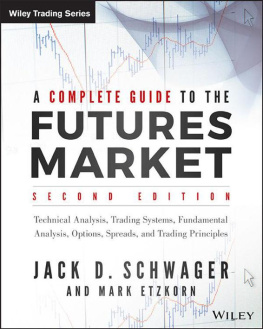Table of Contents
Additional Praise forThe Evaluation and Optimization of Trading Strategies
The decisive step in system trading is the determination of the reliability and robustness of your system. This greatly expanded and very accessible new edition of Bobs classic presents a thorough yet easy to apply and timetested methodology to accurately make this determination. This makes it possible to form a realistic idea of how your system should perform in the future and increases the likelihood of lasting real-time trading profit.
Murray Ruggerio, Vice President of Research and Development for TradersStudio; Contributing Editor Futures Magazine.
Bob Pardo has re-written his own excellent book, and made it even better. It contains a basic step-by-step guide to building a trading system, along with an introduction to advanced system building concepts and tools. Simply avoiding the problems and errors Bob warns about can help lead to real time success. A must read for anyone interested in a systematic approach to trading.
Michael Tepper, Atlas Capital Management, Inc.
A significant contribution that will present, explain, clarify, and illustrate Algo Trading strategies and how to properly test/optimize trading models, thoroughly researched and perceptive. It will give the reader very practical and seasoned insight into the world of Algo Trading. Bob Pardo brings a very lucid approach to a very esoteric subject; a welcome departure from most texts. It is both accessible and rigorous, which is quite rare.
Bruce J. Serra, Vice President, Institutional Sales, MF Global Inc.
Founded in 1807, John Wiley & Sons is the oldest independent publishing company in the United States. With offices in North America, Europe, Australia and Asia, Wiley is globally committed to developing and marketing print and electronic products and services for our customers professional and personal knowledge and understanding.
The Wiley Trading series features books by traders who have survived the markets ever-changing temperament and have prosperedsome by reinventing systems, others by getting back to basics. Whether a novice trader, professional or somewhere in between, these books will provide the advice and strategies needed to prosper today and well into the future.
For a list of available titles, please visit our Web site at www.WileyFinance.com.
Foreword
My relationship with Bob Pardo goes back to 1996 when he approached my firm, DUNN Capital Management, in search of trading capital for his XT99 system. After some extensive system evaluations, we entered into an agreement to help research, develop, and trade Bobs XT99 for Bob, DUNN, and our clients. I am pleased to report that this arrangement has proved beneficial to all parties and that it is still going great guns. When Bob recently asked if I would write the foreword for this second edition I assured him that I would be more than delighted to do so.
Because of my scientific background and training we have always viewed system design and development as a diligent application of statistical analysis of the performance of trading models and of their test results. Accordingly, we were very pleased to find that many of these features were used in developing the XT99 model platform and that it was so amenable to further testing and fine-tuning.
When my colleagues and I had the opportunity to read the first edition of this work, we were particularly interested in Bobs presentation of the virtues and benefits of using the walk-forward method to guide system development.
I am aware that many consider the first edition of this book to be a classic. Generally speaking, it is pretty difficult to improve upon a classic, but in this case it was necessary. As Bob outlines in his preface, to say that our world of computing, trading, and money management has changed since 1991 when the first edition of this book was published, would be a dramatic understatement. Given the vast changes that have occurred since the first edition, a new edition of Bobs book addressing these matters is entirely in line. The good news here is that not only did Bob update the original material; he also reorganized it, explained the material with even greater clarity and insight and added some new insights that he has learned in the intervening years. Did he improve on a classic? Youll have to be the judge of that yourself.
I have always been impressed with Bobs technical toolbox and his innovative ideas. Bobs focus, dedication, and originality as a researcher and trader are very apparent in this second edition. I think that serious system developers will find this second edition a very interesting and profitable read.
Enjoy it.
William A. Dunn, PhD
Chairman
DUNN Capital Management
Stuart, Florida
May 2007
Preface
THERE AND BACK AGAIN
The first edition of Design, Testing, and Optimization of Trading Systems (DTOTS, as I always think of it) was published in 1991. It would be an understatement to say that the world has changed dramatically in the 17 years between the 1991 edition and this one. Some would say the markets have changed also. I disagree.
The markets do what they always do: incorporate all of the changes in communication, technology, wealth, and trading styles into the instantaneous calculation of their fair value.
I have always considered the defining characteristic of markets to be their ability to adapt and alter themselves accordingly to the changing style of market participants.
In this introduction, we review the principal changes that have occurred during this time and their impact on the markets and trading. Many will seem obvious. Please bear with me in this walk down memory lane, however, for the sum total of these changes has altered the nature of trading and our industry in ways that directly reflect upon the current art of the design and evaluation of trading strategies.
How? you might ask, and that would be a very good question. Let me start by offering my reflections on that subject because it is highly relevant to the topic at hand.
The Trading System: From Rock Bottom to Rock Star
The first, and perhaps foremost, difference was that in the early 1990s, the argument that raged was about whether trading systems actually worked. For those who are relatively new to the industry, this might come as a bit of a shock. There is now such a widespread, and somewhat unquestioned, belief in the many virtues of algorithmic trading (AT) that it almost borders on religious belief.
As one who was rather instrumental in the acceptance of the benefits of algorithmic trading, I find both of these polar opposite beliefs somewhat troubling. I was trained in and always have been a fierce advocate of the scientific method and the empirical approach. I have always believed in the critical method.
In our business, the trader who does not apply these methods consistently, rigorously, and religiously along with a healthy dose of skepticism is a trader doomed to failure.
I believed then, and even more so now, that algorithmic trading, when performed correctly and based upon exhaustive research, is the most effective method for large-scale trading. Those of you who go on to read this book will find out in detail why I believe this to be so.








